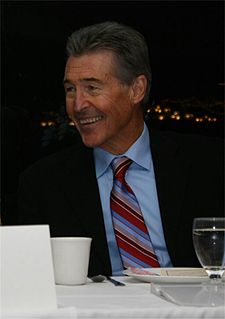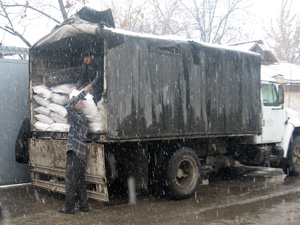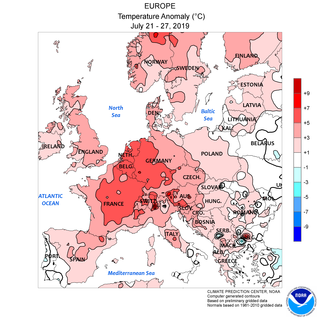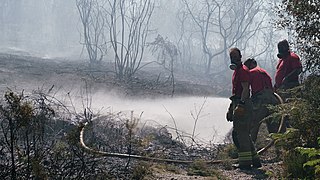Plot
When the heat wave eventually causes a total blackout that shuts down the brokerage firm where Frank works, he and Laura decide to relocate to a mountain cabin in a remote small town—which is also affected by the heat, blackout, and water shortage.
On the way to the cabin, the Taylors' car is taken from them; and they are forced to walk eight miles to the town. When the Taylors reach the town, they go to see Dr. Grayson, who appears to be Laura's old family physician. Dr. Grayson advises Laura that it is important for her to rest given the stress she has been under in the hot, dry conditions.
After Laura has seen the doctor, the Taylors go to the cabin and find two young hikers have taken shelter there. After being briefly angry, the Taylors decide to allow the hikers to stay.
Laura rests in the cabin. However, she still gives birth prematurely.
After the baby is born, Dr. Grayson states the baby cannot survive without being in an incubator, particularly because of the extreme conditions. Dr. Grayson also states that he not only has no incubator but that he would be unable to run one as he has no fuel for his generator. (He is out, and the pumps fuel stations use are powered by electricity). However, with the assistance of the hikers and two town residents, Frank is able to build and power a makeshift incubator.
When the baby has been placed in the incubator, the characters hear that it is raining, which—in the movie—indicates the heat wave has broken and the water shortage will end.
An energy crisis or energy shortage is any significant bottleneck in the supply of energy resources to an economy. In literature, it often refers to one of the energy sources used at a certain time and place, in particular, those that supply national electricity grids or those used as fuel in industrial development and population growth have led to a surge in the global demand for energy in recent years. In the 2000s, this new demand – together with Middle East tension, the falling value of the US dollar, dwindling oil reserves, concerns over peak oil, and oil price speculation – triggered the 2000s energy crisis, which saw the price of oil reach an all-time high of $147.30 per barrel ($926/m3) in 2008.

A heat wave, or heatwave, is a period of excessively hot weather, which may be accompanied by high humidity, especially in oceanic climate countries. While definitions vary, a heat wave is usually measured relative to the usual weather in the area and relative to normal temperatures for the season. Temperatures that people from a hotter climate consider normal can be called a heat wave in a cooler area if they are outside the normal climate pattern for that area.

The 2003 European heat wave saw the hottest summer recorded in Europe since at least 1540. France was hit especially hard. The heat wave led to health crises in several countries and combined with drought to create a crop shortfall in parts of Southern Europe. The European death toll has been estimated at more than 70,000.

Randolph Mantooth is an American actor who has worked in television, documentaries, theater, and film for more than 40 years. A graduate of the American Academy of Dramatic Arts, he was discovered in New York by a Universal Studios talent agent while performing the lead in the play Philadelphia, Here I Come. After signing with Universal and moving to California, he slowly built up his resume with work on such dramatic series as Adam-12 (1968), Marcus Welby, M.D. (1969), McCloud (1970) and Alias Smith and Jones (1971).

Day of the Animals is a 1977 American natural horror film directed by William Girdler, based on a story by producer Edward L. Montoro. The film reunited Girdler and Montoro with stars Christopher George and Richard Jaeckel from the previous year's Grizzly. It co-stars Lynda Day George and Leslie Nielsen.

The 2008 Central Asia energy crisis was an energy shortage in Central Asia, which, combined with the severe weather of the 2007-08 winter and high prices for food and fuel, caused considerable hardship for many. The abnormally cold weather has pushed demand up for electricity, exacerbating the crisis. The situation was most dire in Tajikistan. An international appeal was made by the United Nations, NGOs, and the Red Cross and Red Crescent for around US$25 million to assist the government. At the time, The UN warned that millions face starvation during the 2008-09 winter.

The 2009 southeastern Australia heat wave was a heat wave that commenced in late January and led to record-breaking prolonged high temperatures in the region. The heat wave is considered one of the, if not the, most extreme in the region's history. During the heat wave, fifty separate locations set various records for consecutive, highest daytime and overnight temperatures. The highest temperature recorded during the heat wave was 48.8 °C (119.8 °F) in Hopetoun, Victoria, a record for the state. Many locations through the region recorded all-time high temperatures including capital cities Adelaide, which reached its third-highest temperature, 45.7 °C (114.3 °F), and Melbourne, which recorded its highest-ever temperature on record, 46.4 °C (115.5 °F). Both cities broke records for the most consecutive days over 40 °C (104 °F), while Mildura, Victoria recorded an all-time record twelve consecutive days over 43 °C (109 °F).
The United Kingdom heatwave of 1911 was a particularly severe heat wave and associated drought. Records were set around the country for temperature in England, including the highest accepted temperature, at the time, of 36.7 °C (98.1 °F), only broken 79 years later in the 1990 heatwave, which reached 37.1 °C (98.8 °F). The highest ever accepted temperature is currently 40.3 °C (104.5 °F) recorded on the 19 July 2022 in Coningsby, Lincolnshire. Weather in Northern Europe was also affected around about this time.

The 2010 Northern Hemisphere summer heat waves included severe heat waves that impacted most of the United States, Kazakhstan, Mongolia, China, Hong Kong, North Africa and the European continent as a whole, along with parts of Canada, Russia, Indochina, South Korea and Japan during May, June, July, and August 2010. The first phase of the global heatwaves was caused by a moderate El Niño event, which lasted from June 2009 to May 2010. The first phase lasted only from April 2010 to June 2010, and caused only moderate above average temperatures in the areas affected. But it also set new record high temperatures for most of the area affected, in the Northern Hemisphere. The second phase was caused by a very strong La Niña event, which lasted from June 2010 to June 2011. According to meteorologists, the 2010–11 La Niña event was one of the strongest La Niña events ever observed. That same La Niña event also had devastating effects in the Eastern states of Australia. The second phase lasted from June 2010 to October 2010, caused severe heat waves, and multiple record-breaking temperatures. The heatwaves began in April 2010, when strong anticyclones began to develop, over most of the affected regions, in the Northern Hemisphere. The heatwaves ended in October 2010, when the powerful anticyclones over most of the affected areas dissipated.

Flight 7500 is a 2014 American supernatural horror film directed by Takashi Shimizu and starring Leslie Bibb, Jerry Ferrara, Ryan Kwanten, and Amy Smart. It revolves around a supernatural force on a plane. The film is loosely based on the Helios Airways Flight 522 incident that took place in 2005. The film was released in the United States on April 12, 2016, by CBS Films and Lionsgate, after being released theatrically in Asia.

Wild is a 2014 American biographical adventure drama film directed by Jean-Marc Vallée and starring Reese Witherspoon, with Laura Dern, Thomas Sadoski, Michiel Huisman, Gaby Hoffmann, Kevin Rankin, and W. Earl Brown appearing in supporting roles. The screenplay was adapted by Nick Hornby from Cheryl Strayed's 2012 memoir Wild: From Lost to Found on the Pacific Crest Trail, which is about a solo backpacking trip Strayed undertook on the trail in 1995 after numerous personal issues had left her life in shambles.
The 2016 Indian heat wave was a major heat wave in April and May of that year. A national record high temperature of 51.0 °C (123.8 °F) was set in the town of Phalodi, in the state of Rajasthan. Over 160 people died with 330 million affected to some degree. There were also water shortages with drought worsening the impact of the heat wave.

The 2018 European drought and heat wave was a period of unusually hot weather that led to record-breaking temperatures and wildfires in many parts of Europe during the spring and summer of 2018. It is part of a larger heat wave affecting the northern hemisphere, caused in part by the jet stream being weaker than usual, allowing hot high-pressure air to linger in the same place. According to the European Drought Observatory, most of the areas affected by drought are across northern and central Europe. According to the World Meteorological Organization, the severe heat waves across the northern hemisphere in the summer of 2018, are linked to climate change in Europe, as well as events of extreme precipitation.

In late June and late July 2019 there were two temporally distinct European heat waves, which set all-time high temperature records in Belgium, France, Germany, Luxembourg, the Netherlands, and the United Kingdom.
2022 saw a rapid increase in food prices and shortages of food supplies around the world. The compounding crises in distinct parts of the world were caused by compounding geopolitical and economic crisis. The crises follow food security and economic crises during the COVID-19 pandemic.

The 2022 heat wave in India and Pakistan is an extreme weather event which has resulted in the hottest March in India since 1901. The hot season arrived unusually early in the year and extended into April, affecting a large part of India's northwest and Pakistan. The heatwave has combined with a drought, with rainfall being only a quarter to a third of normal. The heat wave is remarkable for occurring during a La Niña event.

The 2022 United Kingdom heat waves were periods of unusually hot weather in the United Kingdom caused by rising high pressure up from the European Continent, reaching its peak between 17 to 19 July and resulting in top temperatures of over 40 °C (104 °F).

From June to August 2022, persistent heat waves have affected parts of Europe, causing wildfires, droughts, evacuations and heat-related deaths. The highest temperature recorded was 47.0 °C (116.6 °F) in Pinhão, Portugal, on 14 July. During this heat wave, nearly 12,000 people died from heat stroke or other means, making it the deadliest natural event since the 2011 East Africa drought, and the deadliest heat wave since the 2010 Russian heat wave.
2020s in climate history refers to major events pertaining to the climate, this includes extreme weather, as well as new scientific phenomena and occurrences which pertain to the climate. This article will be structured by category of data, and then chronologically within those broader sections.













